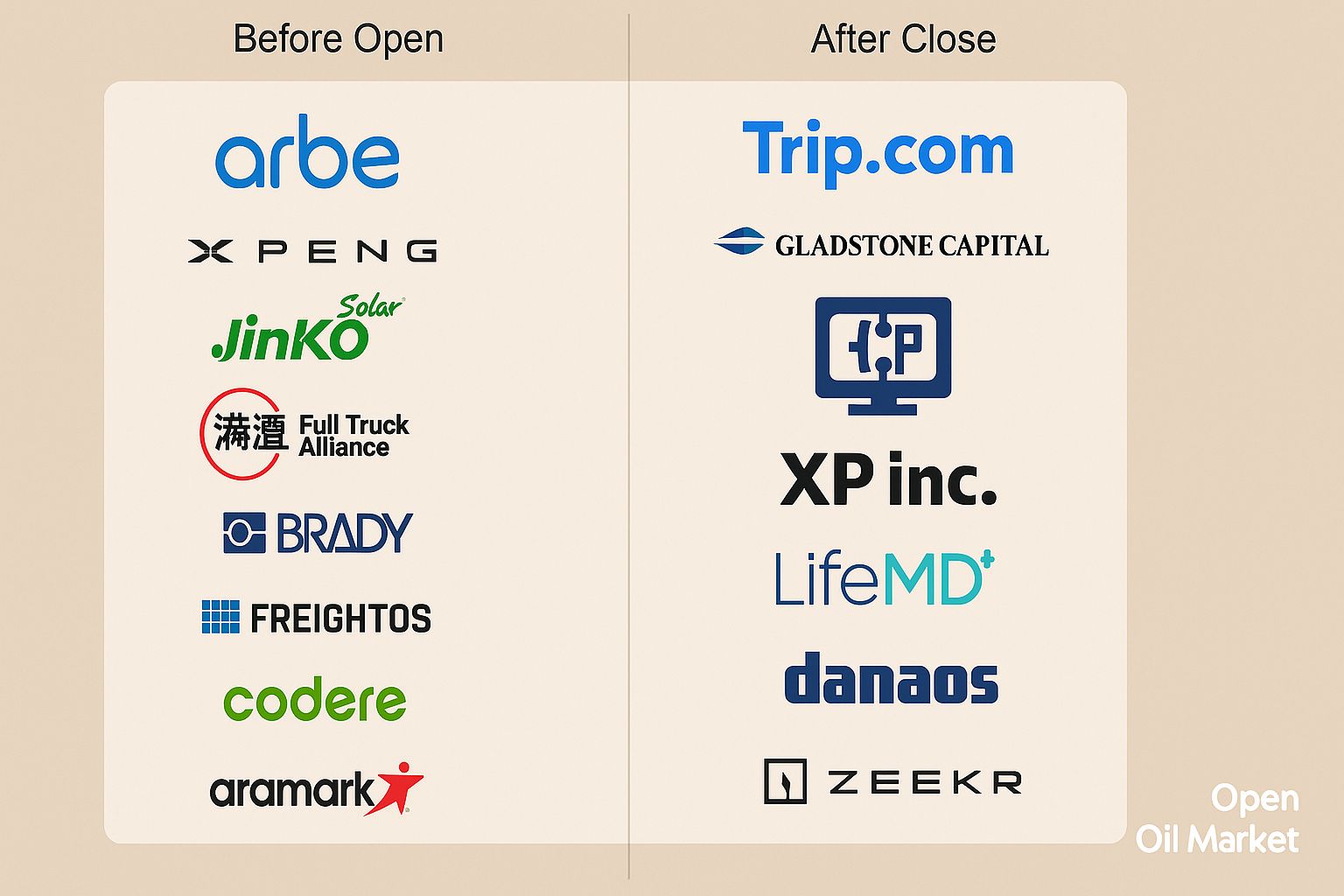
Overview of Key Macroeconomic Data and Corporate Earnings on 17 October 2025: US Non-Farm Payrolls, EU CPI, Earnings Reports from American Express, Schlumberger, China Mobile, and Other Companies. Forecasts, Analysis, and Market Impact.
Global IMF and World Bank Meetings – Day 5
Friday marks the concluding fifth day of the annual IMF and World Bank meeting. Throughout the week, financial leaders and central bankers have discussed global economic prospects, inflationary risks, and financial stability. The final phase of the meetings may yield important commentary from central bank leaders – investors are keenly awaiting signals regarding future monetary policy. Any statements regarding global growth rates, emerging market debt, or regulatory coordination will be closely examined by the market. The outcomes of these discussions are likely to influence overall risk appetite; for instance, optimistic forecasts may bolster global equity indices, while warnings about potential risks could heighten investor caution.
Inflation in the Eurozone: Final CPI Data for September
European investors are anticipating the release of the final consumer price index (CPI) for the Eurozone for September. Preliminary estimates indicated an acceleration of inflation to approximately 2.2% y/y (up from 2.0% in August), slightly above the European Central Bank's target. The final figures will confirm whether this uptick has persisted. Core inflation in the region also remains around 2–3%, signalling that inflationary pressures have not yet fully abated. For the ECB, this data is crucial: a consistent slowdown in inflation would potentially allow the regulator to pause interest rate hikes, whereas an increase could prompt new discussions regarding monetary policy. Markets will react to the CPI report with movements in the euro and European bonds: higher inflation may heighten expectations for further ECB actions, while weak price growth would support a dovish outlook from the regulator.
US Housing Market: Housing Starts Data for September
In the afternoon, statistics on housing construction in the US – Housing Starts for September – will be released. This indicator reflects the number of new housing projects initiated and serves as a significant barometer for the state of the economy and the real estate market. In an environment of high mortgage rates (nearing multi-year highs), construction activity has notably declined in recent months. In August, the volume of housing construction was around 1.3 million homes on a seasonally adjusted annual rate (SAAR), one of the lowest figures in recent years. September forecasts suggest stabilisation around these levels, as costly loans and high material prices continue to restrain builders. Should the report indicate an unexpected increase in new home starts (for example, a significant rise beyond anticipated levels), it could suggest some adaptation within the industry to high interest rates and support shares of construction companies. However, further declines in Housing Starts may heighten concerns regarding economic slowdown and could weigh on related sectors (developers, building material manufacturers).
US Labour Market: Non-Farm Payrolls and Unemployment
The key event of the day will be the official US labour market report for September – Non-Farm Payrolls, due at 15:30 Moscow time. Employment data outside the agricultural sector will reveal how many jobs were created (or eliminated) in the US economy over the month. Analysts anticipate a modest increase of around +50 thousand new jobs, which is expected to slightly exceed the weak result from August (+22 thousand) but remain significantly below the average pace observed earlier this year. Such a deceleration in hiring indicates a cooling economy under the influence of previous Federal Reserve interest rate hikes. The unemployment rate is expected to remain around 4.3% (consistent with the previous month). Investors will analyse the report's details closely:
- Sectors of Growth or Decline: an important signal will be which sectors experience significant changes in employment. For instance, hiring growth in services alongside a contraction in manufacturing would confirm a shift towards a service-oriented economy.
- Wage Growth: the dynamics of average hourly earnings influence inflation expectations. Moderate wage growth will support the view that inflation is easing, while a surge in wages could alarm the Fed.
- Revisions to Previous Data: revisions to figures from previous months can impact perceptions of trends. If, for example, the employment figure for August is revised upwards, this would mitigate the negativity from the weak new data.
Market reactions to the Non-Farm Payrolls report are typically intense: stronger-than-expected job growth may trigger a spike in Treasury yields and pressure on equity indices, as it would raise the likelihood of further tightening from the Fed. Conversely, weak data (or an uptick in unemployment) could benefit equities and bonds, increasing hopes for a swift conclusion to the rate-hiking cycle. The labour market report, postponed to a later date (17 October) due to a recent US government shutdown, will be a determining factor in trading as the week concludes.
US Industrial Production for September
Shortly after, at 16:15 Moscow time, statistics on US industrial production for September will be released. This measure reflects output in manufacturing, energy, and mining sectors. In the previous month, US industry showed a modest growth of around +0.1% m/m, partly due to increased automobile production and stable oil extraction. Expectations for September are cautious: economists forecast around 0% – +0.1% change, pointing to a continued weak spot in the economy. A strong dollar, high rates, and moderate consumer demand are affecting industrial output. An additional factor may have been a strike by autoworkers (if it occurred in September), which would have temporarily reduced automobile output. If the report reflects a greater-than-expected decline in industrial production, it would confirm recession risks for the industrial sector and may negatively impact shares in this sector and commodity prices. Conversely, modest growth or flat dynamics would be interpreted neutrally, while an unexpected increase in output would be a positive surprise, indicating resilience in the US economy amid constraining factors.
Oil and Gas Sector: Baker Hughes Rig Count
At 20:00 Moscow time, the weekly Baker Hughes report on active oil and gas rigs in the US will traditionally be published. This indicator indirectly signals activity levels among extraction companies and their expectations regarding oil and gas prices. In the previous reporting period, the total number of rigs in the US was around 547 units, continuing a declining trend. Over the past year, the number of active rigs has decreased by approximately 7%, indicating producers' caution amid price volatility and their focus on efficiency rather than expanding drilling volumes. Should recent data show a further decline in rig counts, it might be interpreted as a sign of potential future supply constraints in the oil market – a factor supporting oil prices. Conversely, an increase in the number of rigs (for instance, for the first time in several weeks) would signal a return of confidence among oil and gas producers, likely due to consistently high energy prices. Investors in the commodities segment will pay particular attention to this release, as it impacts oil prices, shares of oil and gas companies, and even currencies of commodity-exporting countries.
US: Earnings Reports from American Express, Schlumberger, and Regional Banks
The corporate earnings season in the US is in full swing – on 17 October, several large American companies will publish their financial results for the third quarter. Among the key players:
- American Express (AXP) – a leading payment system and credit card issuer. Investors anticipate a robust profit growth amid sustained spending on premium cards and a recovery in business travel. Analysts forecast that AmEx’s quarterly profit could increase by ~15% year-on-year, with revenue growth of 8–10%. Management’s commentary on consumer spending will be in focus: is high demand from cardholders persisting or are there signs of economising due to high rates? The market will also assess the delinquency rates in American Express’s credit portfolio – a reflection of borrower financial health.
- Schlumberger (SLB) – the world’s largest oilfield services company. Its results will provide insights into the state of the oil industry. Expectations for Schlumberger are modest: due to a slowdown in drilling activity in North America and the deferral of some projects, analysts forecast a profit decline of around 20–25% year-on-year. Investors will be interested in new orders and management’s outlook for oilfield services amid steady oil prices around $80–90 per barrel. Should Schlumberger report growth in international projects (for example, in the Middle East) or increased margins due to technology, it would support confidence in the oilfield services sector.
- State Street (STT) – one of the largest custodial banks and providers of financial services for institutional investors. State Street's report will indicate how market volatility and rising bond yields have impacted its fee income and assets under management. High interest rates may have increased the bank's interest income from idle funds while also lowering asset valuations. Investors will assess whether State Street managed to grow its client base and maintain profitability amidst challenging market conditions.
- Regional Banks in the US – on Friday, several large regional financial institutions will present their reports: Truist Financial, Fifth Third Bancorp, Regions Financial, Huntington Bancshares, Ally Financial, and others. These banks operate in different states and sectors (consumer and commercial lending, auto loans, mortgages), and their results will serve as a barometer for the health of the banking system at the local level. Key metrics to watch include: net interest margin (how income from loans has risen amid higher rates and the cost of raising deposits), deposit dynamics (whether client funds were retained after the spring stresses in the sector), the volume of reserves for potential loan losses, and default rates. So far, high rates have bolstered bank profits due to expensive loans but have also increased default risks. Management's commentary on the economic state in their regions (credit demand, real estate market conditions, business forecasts) will be crucial for assessing sector outlook.
Europe: Volvo Report and Other Corporate Earnings
The European corporate agenda on 17 October is also busy, although most reports will come from second-tier companies. Among the most significant:
- AB Volvo – a Swedish manufacturer of trucks and construction equipment. Volvo’s third-quarter results will illustrate the situation in the global industrial cycle. Previously, the company warned of demand normalisation following record orders in recent years. A decrease in revenue and profits compared to last year is expected due to weaker sales in Europe and North America, as well as increasing costs. Investors will focus on the volume of new truck orders and management’s forecasts: will cautious demand from carriers and construction companies persist or will the market stabilise? Volvo shares are sensitive to any signals of changing dynamics in the industry.
- Yara International – a major Norwegian producer of mineral fertilizers. Yara’s report will demonstrate how the company is adapting to price volatility in fertilisers and energy. Following a sharp decline in fertiliser prices in 2023–2024, the company has faced falling profits. The trend may have continued in the third quarter: revenue may remain under pressure due to weak demand and low gas prices. However, investors will be seeking signs of recovery, such as an increase in fertiliser sales as farmers restart purchases. Comments on gas prices (a key feedstock in ammonia production) will also be significant: a decrease in gas prices in Europe may have supported Yara’s profitability.
- Other European Companies – among companies releasing reports or operational statistics on this day, notable mentions include:
- Pearson plc (UK) – an educational publisher that will provide a trading update reflecting sales of educational materials and digital services. Investors will assess the progress Pearson has made in restructuring its business towards digital platforms and the demand for educational products post-pandemic.
- Tomra Systems ASA (Norway) – a manufacturer of reverse vending machines, will report its results. The company is favourably positioned within the ecology and recycling trends, but its growth may have slowed due to delays in implementing new projects. The report will clarify the situation regarding orders for deposit systems and the margin across segments.
- Avanza Bank (Sweden) – an online bank and broker popular among retail investors, will publish its financial results. The market will learn how volatility and decreased activity in equity markets have impacted the platform's fee income and new client inflows.
- Basic-Fit N.V. (Netherlands) – an operator of fitness club chains, will provide a business update. Investors will monitor whether the number of subscribers and clubs has continued to grow post-pandemic and how inflation in costs (rent, electricity) is affecting profitability.
Asia: Earnings Reports from China Mobile, Reliance and Market Dynamics
The Asian session on 17 October also brings several important corporate publications, primarily from China and India:
- China Mobile – China’s largest telecommunications operator will present its financial results for the third quarter. Generally, the company’s business is characterised by stability: revenue growth primarily stems from the expansion of 5G services and increased traffic consumption. Investors will focus on the growth rates of new mobile subscribers and broadband users, as well as ARPU (average revenue per user) figures. Amid the slowing Chinese economy, important signals will be whether weak macroeconomic conditions are affecting customers' payment capabilities and corporate demand for communications. The market is also interested in China Mobile’s plans for technological advancements (such as cloud services) and profit distribution (dividends).
- Reliance Industries – an Indian conglomerate, will publish its financial figures for the second quarter of the 2026 financial year. Reliance serves as a barometer for the Indian economy, with its business encompassing oil refining, petrochemicals, telecommunications (Jio), and retail. The telecom division, Jio, is expected to have continued increasing its number of users and profits thanks to its dominant market position in India. The retail segment could also facilitate contribution through the expansion of store networks. However, the petrochemical division likely faced pressure due to low margins and pricing for plastics. Investors will evaluate Reliance’s overall profit and management comments – especially regarding plans for spinning off the Jio business or potential IPOs of the retail division, topics that have long been discussed in the market.
- Zijin Mining – a major Chinese mining company specialising in gold, copper, and other metals. Its results for the third quarter will reveal how the mining sector in China is benefitting from rising gold prices (around $1900–2000) and recovering demand for industrial metals. If Zijin’s profits have risen significantly, it could indicate a favourable environment in the precious metals sector and stimulate infrastructure projects in China (increasing demand for copper). However, any mentions of regulatory restrictions or rising costs (energy, labour) could also impact company outlook.
It is worth noting that no major corporate reports are scheduled in Japan on 17 October, as most companies in the Nikkei 225 index will release financial results for the half-year closer to the end of October. Therefore, Asian investors will primarily react to the reports from the aforementioned Chinese and Indian corporations, as well as the external context shaped by global events of the day.
Key Considerations for Investors
Thus, as the week draws to a close, both macroeconomic and corporate factors simultaneously impact the markets. Investors should pay particular attention to the following points:
- US Data Tone: the combination of the Non-Farm Payrolls report, housing, and industrial statistics will provide a comprehensive view of the state of the world’s largest economy. If indicators collectively point to a slowdown (weak hiring, reduced construction, stagnation in output), it could strengthen expectations for future Fed policy easing and support the equity market. However, in the case of a mixed picture or unexpectedly strong employment data, volatility may increase – investors need to be prepared for fluctuations in indices and adjustments in bond market rates.
- Central Bank Reactions: the outcomes of the IMF/WB meetings and inflation indicators in Europe will be interpreted through the lens of future central bank decisions. Any “hawkish” signals (for instance, comments suggesting the need for further rate hikes due to inflation) could dampen risk appetite, especially in emerging markets. Conversely, signs of stabilisation in prices and soft statements from regulators will support a positive sentiment.
- Corporate Surprises: ongoing corporate reports could locally influence individual stocks and sectors. Investors in the banking sector should keep an eye on the margins and asset quality of regional US banks. In the commodities segment, watch for forecasts from Schlumberger and mining companies regarding demand. In the consumer space, monitor American Express’s comments on consumer spending. Any significant deviations from analysts’ expectations could lead to capital reallocation among sectors during the final hours of trading in the week.
In conclusion, Friday promises to be dynamic: the combination of important macroeconomic data and corporate news will set the course for market movements. Investors from the CIS countries should closely follow the publications throughout the day and evaluate their influence on global indices, commodities, and currencies. The week’s final chord – statistics on rig counts and any evening announcements – will help shape the understanding of the market sentiment entering the new week. Caution and readiness to react swiftly to emerging information will be key to successful navigation on such eventful days.




